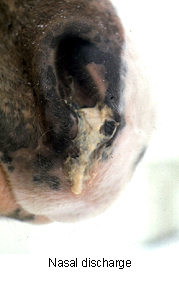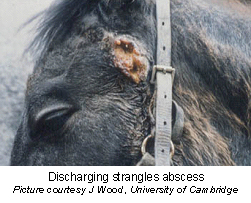Can My Horse Get Strangles Again
What is strangles?
Strangles is an infection caused by bacteria called Streptococcus equi. It is highly contagious and the infection can be spread by equus caballus-to-horse contact or by humans, tack, drinking troughs and other ecology factors.
What should I look for?

Which horses can get affected?
Strangles tin occur in horses of whatsoever age but younger horses are more than likely to become infected. Later infection, well-nigh horses are immune to re-infection for several years. Old or devitalized horses are at increased risk of infection or re-infection.
Tin information technology exist treated?
The bacteria that crusade strangles can be killed by sure antibiotics including penicillin but there is considerable disagreement as to, if or when antibiotic handling should be given.
The trouble is that when abscesses class they produce a dense gristly capsule that means the antibiotics circulating in the bloodstream have difficulty in reaching and killing the infecting organisms. This tends to delay resolution of the infection and there is an increased risk of infection spreading to other lymph nodes throughout the horse'southward torso (miliary or 'bounder' strangles), that is oft a terminal condition. Most clinicians who accept experience of strangles outbreaks therefore prefer to let the disease take its natural course, infecting and immunizing most horses, for an early resolution. A compromise is to take temperatures and blood samples daily from in-contact horses and to treat horses with a course of antibiotics from the very outset sign of infection, before abscesses showtime developing. This may prevent the affliction from manifesting simply may also foreclose them from producing a useful immunity, so they may develop signs in a 'second wave'. Some cases course such big abscesses that they are in danger of suffocation and so intensive antibiotic and anti-inflammatory treatment is essential to relieve their lives.
Recommended treatments include application of hot towels to the swollen glands to encourage abscesses to flare-up or to grow to a size and maturity that allows them to be safely and successfully lanced. Once open, the abscess cavities should be flushed with dilute povidone-iodine solutions and immune to heal naturally.
Can the illness exist prevented?
It is most of import to understand the highly infectious nature of this organism and to all that can be done to isolate cases and to prevent farther spread to other horses, both on and off the immediate premises. Your veterinary will assist you lot set up a management protocol advisable to your own location and circumstances.

Unfortunately, some horses become symptomless carriers of Streptococcus equi, nearly ordinarily in their guttural pouches, and can infect horses intermittently although showing no signs of infection themselves. This is probably the most of import cause of infection recurring at intervals of several months, afterward apparent clearance. Office of the clearance process for recovered cases should therefore be the collection of deep nasopharyngeal swab and guttural pouch wash samples for laboratory investigations.
Vaccination is controversial. The intramuscular vaccines take been associated with relatively low efficacy (approximately l% reduction in disease) and frequent inflammation at the injection site. More recently an attenuated live strain of Southward. equi has been used in an intranasal vaccine. Initially ii doses at two-iii week intervals are administered then annual boosters are recommended. This vaccine should not be administered during an outbreak except to horses with no known contact. No other vaccine should be administered at the same fourth dimension due to take a chance of abscess formation at injection site due to the bacteria contaminating the site.
Are there other or long term complications of the disease?
Strangles can take an unusual course with abscesses forming deep in the body. This is oftentimes termed 'bounder strangles' and can be very difficult to treat successfully. Affected horses may evidence signs of colic or abscesses might discharge internally from many sites. Many horses loose weight and oft require euthanasia on humane grounds with colic, respiratory distress or other complicating illnesses associated with peritonitis, pleuritis and/or multifocal organ damage.
Occasionally a equus caballus becomes a symptomless carrier and this has been discussed above. Often these carriers only spread the infection when they are stressed e.g., at the fourth dimension of foaling or afterwards transportation or handling for farriery or routine worming or vaccination. Unless they tin be successfully treated by guttural pouch medication, it is hard to know how these animals are best managed as they are a serious chance of infection to other horses. This is something else that should exist discussed with your veterinary.
Strangles is rarely fatal but deaths can occur. Occasionally a horse that recovers from strangles will develop a condition known as purpura hemorrhagica. This is due to an unusual immune reaction to the streptococcal bacteria and results in widespread harm to blood vessels, resulting in swellings of the legs and head and bruise-like patches in the mouth. Your veterinary should exist called immediately if yous suspect this life-threatening status.
holifieldyoustwou1977.blogspot.com
Source: https://vcahospitals.com/know-your-pet/strangles-in-horses
0 Response to "Can My Horse Get Strangles Again"
Post a Comment